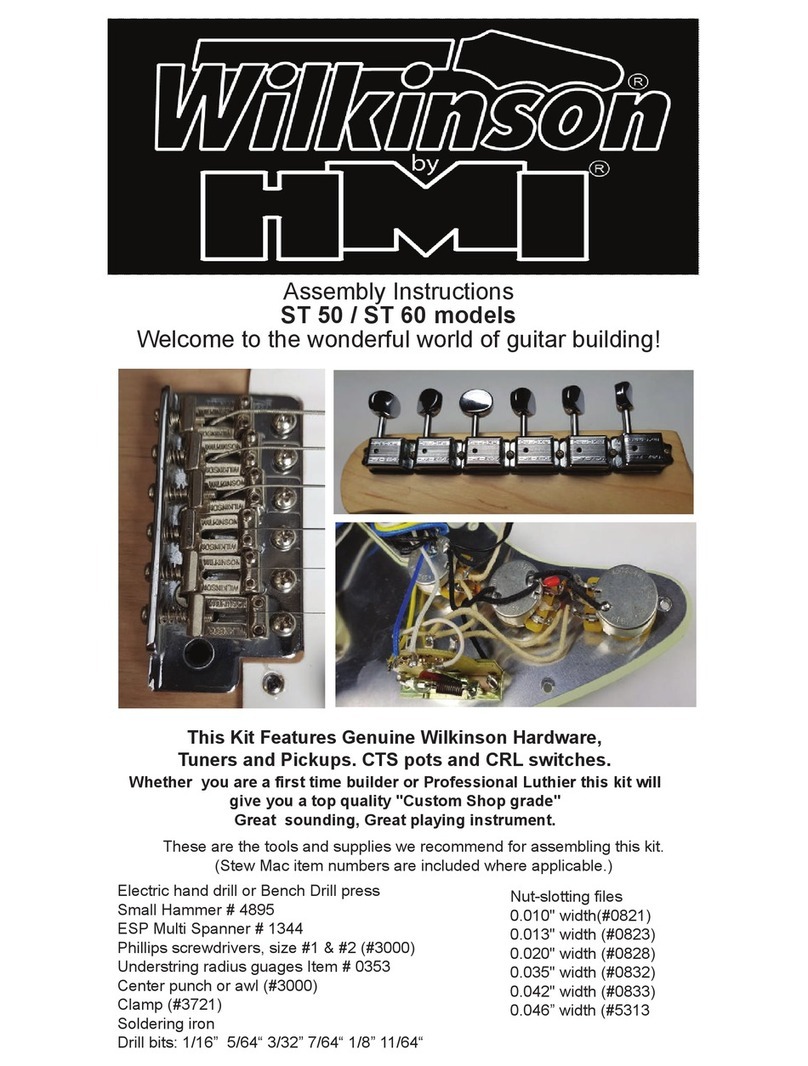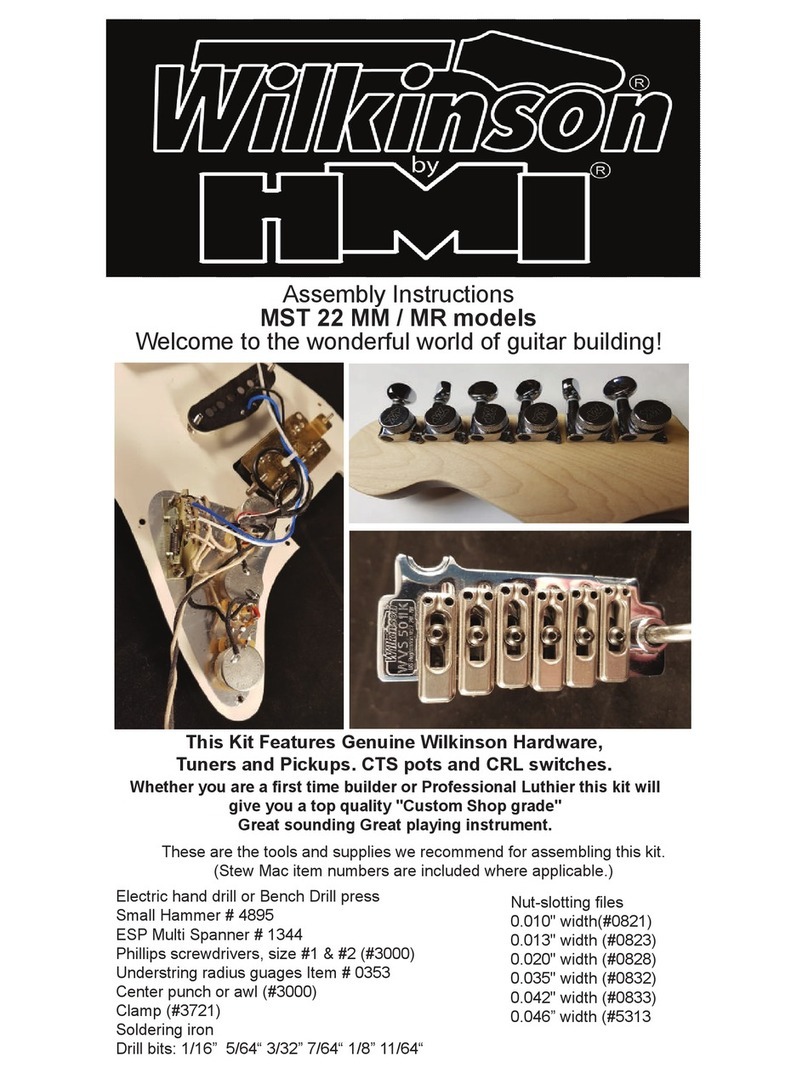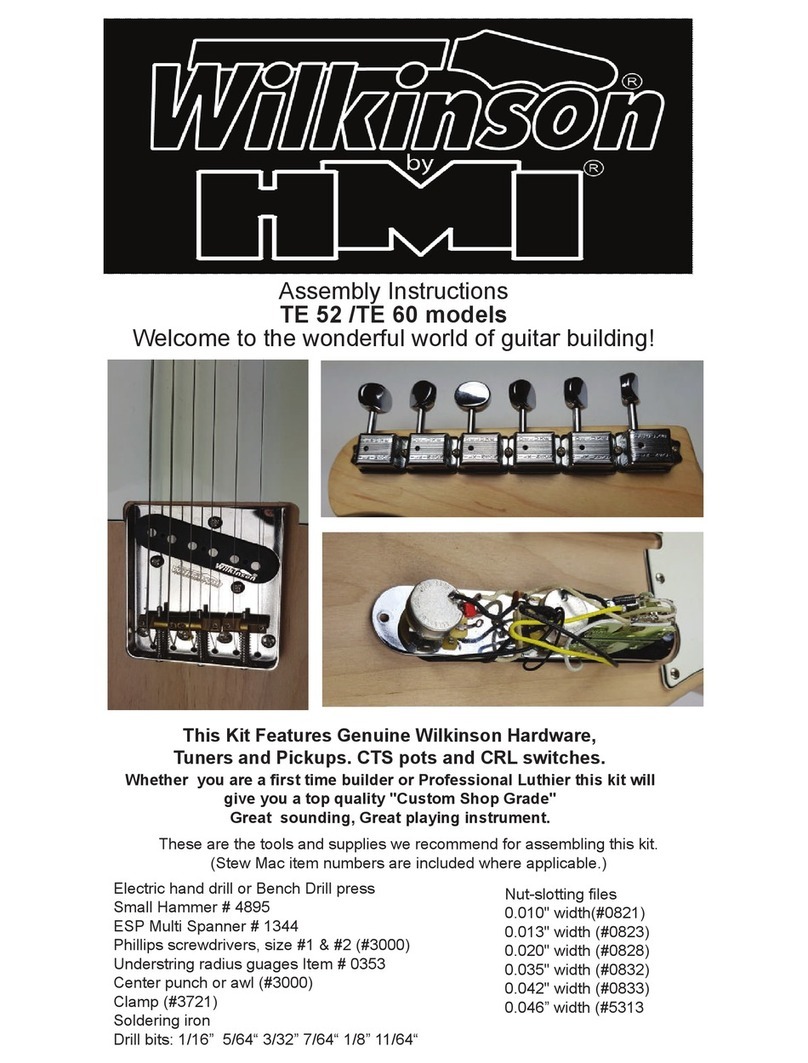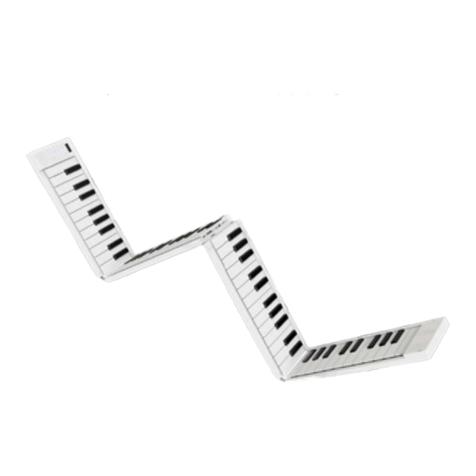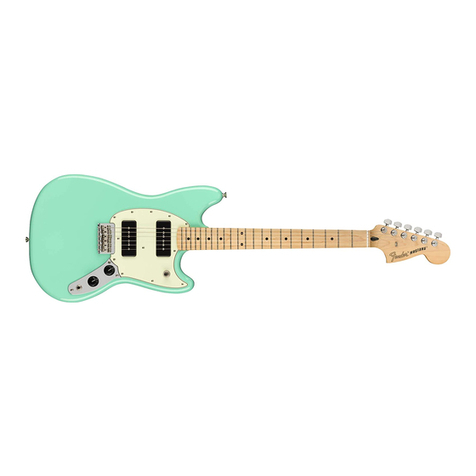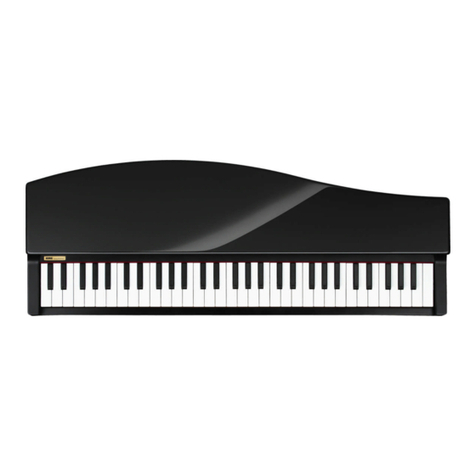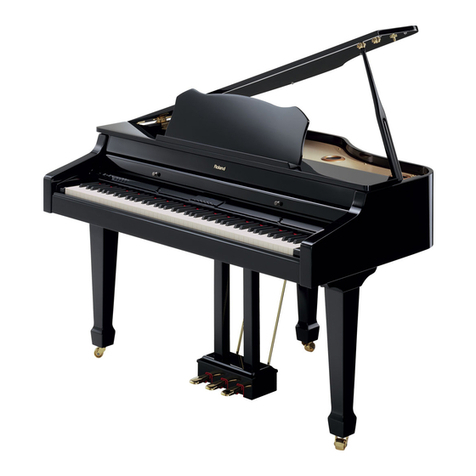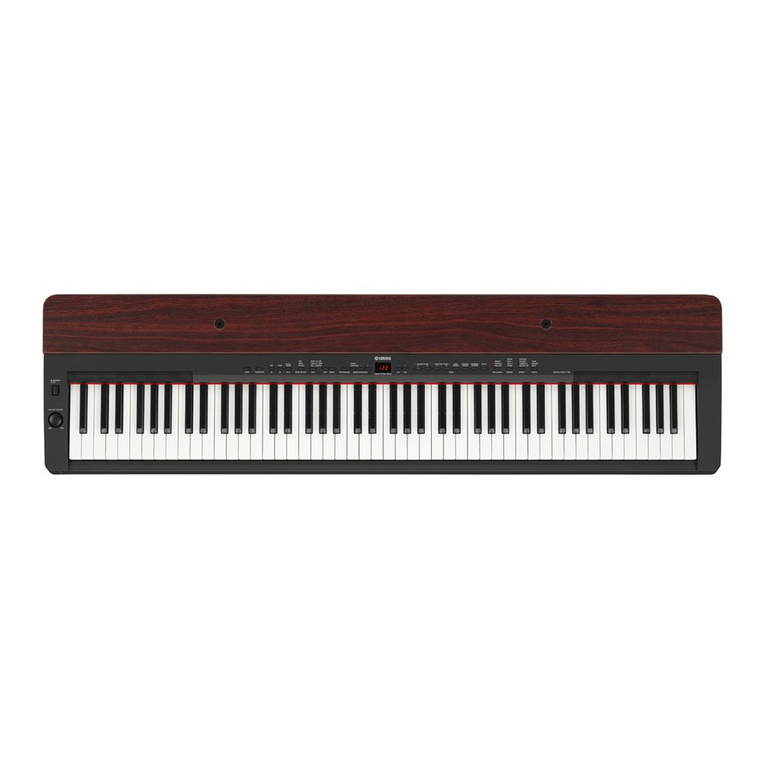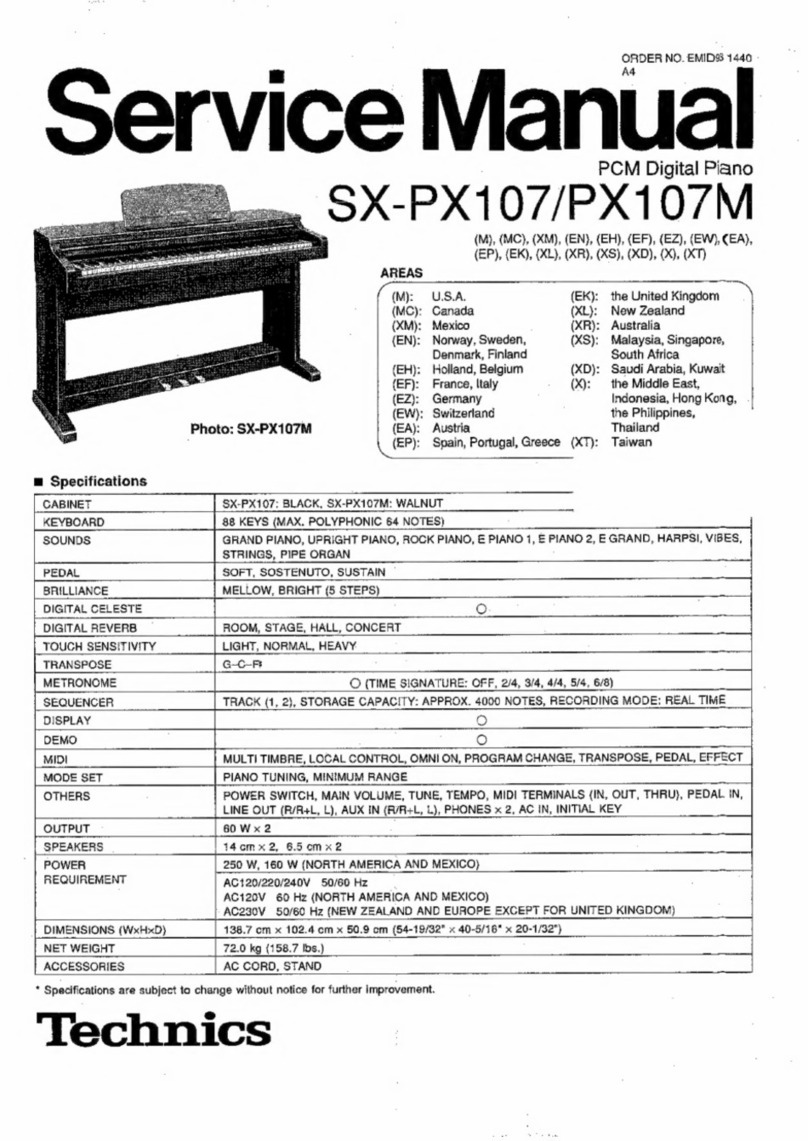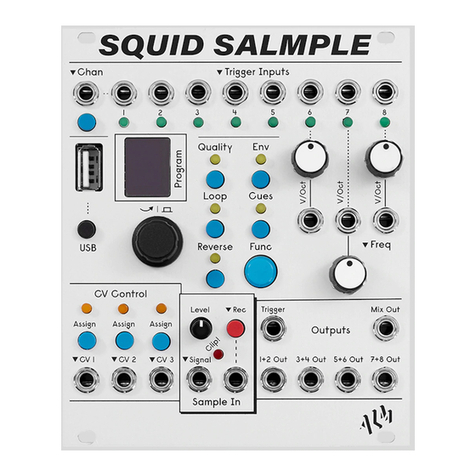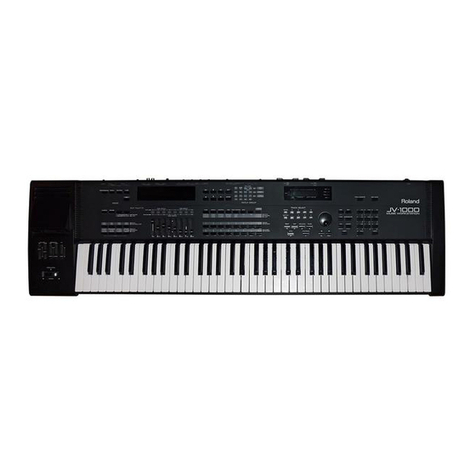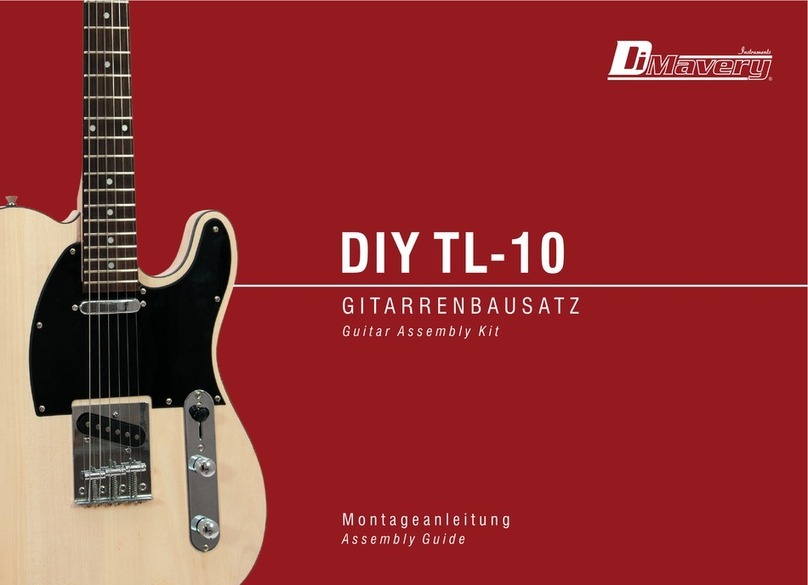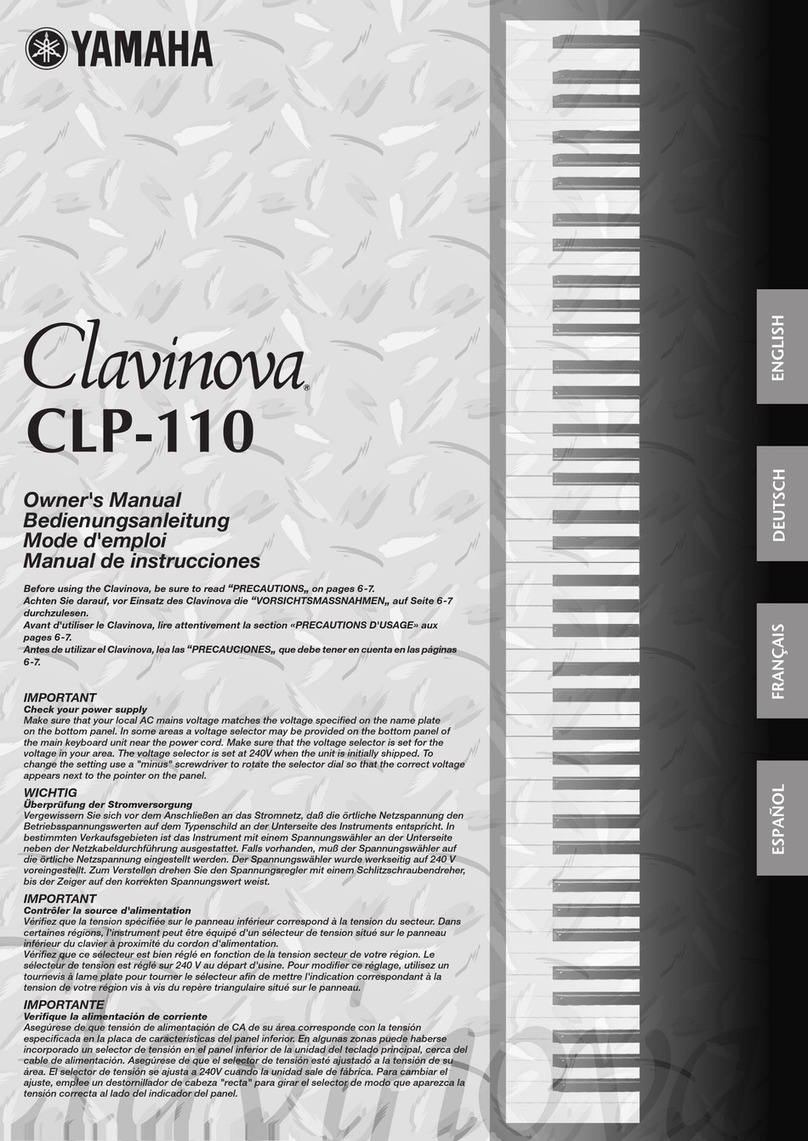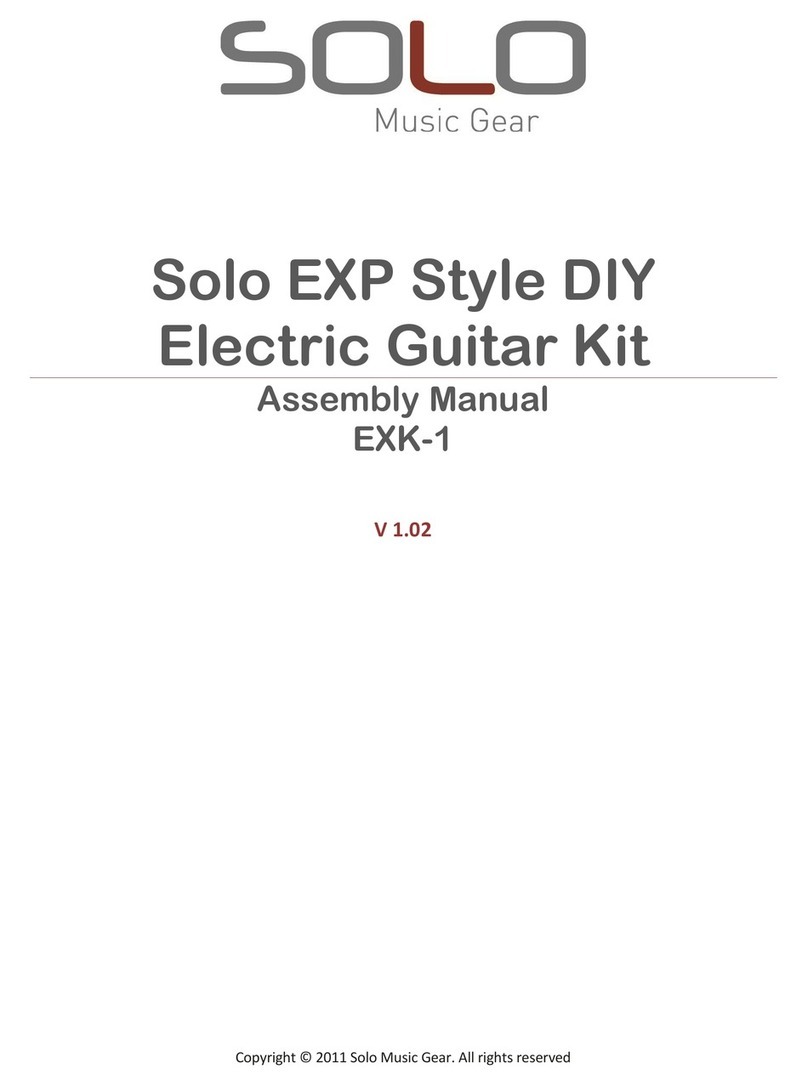HMI Wilkinson MTE 22 MM User manual

Set the action at the nut.
Set the action at the bridge
Adjust the pickup height
The last step is intonating the guitar by adjusting the string lengths
at the bridge so the guitar plays in tune all the way up the neck.
Your Kit model TE52 and TE 60 have WTB bridges with three
saddles (two per string) these are pre-intonated per pair. Setting the
Low E string will compensate for the A setting, the G string intona-
tion will compensate for the D string. The HIgh E string when into-
nated will compensate for the B string. Using a strobe or other
accurate tuner ...First tune the strings to pitch. Then, press the high
E string lightly at the 12th fret using just enough pressure to sound
the note. Check it with your tuner. If the note reads flat, the saddle
needs to be adjusted forward towards the nut, shortening the length
of the string If the note reads sharp, the saddle needs to be adjusted
back away from the nut, increasing the string length.to set the into-
nation. Repeat this process for the G string and the Low E string
Bridges supplied with the MTE kits are “Wilkinson” WTB “DUPLO”
style. These are also a three saddle bridge but with the added
feature of each saddle having a choice of intonation offsets per set
of strings. These off sets are accessed by rotating the saddle on the
intonation screw. Offset 1 is full travel. Off set 2 will redice this offset
by 50%.this can help when using mixed or custom string guages.
Adjust the action at the bridge by raising or
lowering the string saddles. Measure string height over the 12th fret
between the bottom of the string and the top of the fret.
A good starting point is: High (unwound) E string: 1/16" at the 12th
fret..Low (wound) E string: 5/64" at the 12th fret.
You can always go lower or higher depending on your playing style.
After setting the two E strings, dial in the remaining strings to match
the curve of the fretboard. Stew Mac 10” Radius guage included in
the set # 0353 is ideal for this ..
Holding down the low E and high E strings at the 22nd fret, adjust
the bass side of the pickups to 5/64" from the top of the pickup pole
to the bottom of the low E string. Adjust the treble side to 1/16".
Now Re-tune your guitar and check the action. Sight down the neck
and check for any “overbow” (bending backwards) causing string
buzz on an open string or Under bow on the neck causing a higher
than necessary action in the middle of the neck when playing. Adjust
the optimum action with the truss rod.
Set the intonation
Lower your string nut slots for better playability using
gauged nut files. Measure string height over the 1st
fret, between the bottom of the string and the top of the
fret. A comfortable medium action is: Unwound strings
(G, B, E): 0.012" at the 1st fret, Wound strings (E,A,D):
0.020" at the 1st fret Use feeler gauges to measure the
gap, or use guitar strings whose gauges match the
measurement you’re after. Stop when the string sits on
your feeler gauge. Go slow and check your work
frequently—it’s easy to go too far in this step and ruin
the nut.
Your guitar is now be ready to play and ENJOY !!
Assembly Instructions
MTE 22 MM / MR models
Welcome to the wonderful world of guitar building!
These are the tools and supplies we recommend for assembling this kit.
(Stew Mac item numbers are included where applicable.)
Nut-slotting files
0.010" width(#0821)
0.013" width (#0823)
0.020" width (#0828)
0.035" width (#0832)
0.042" width (#0833)
0.046” width (#5313
Electric hand drill or Bench Drill press
Small Hammer # 4895
ESP Multi Spanner # 1344
Phillips screwdrivers, size #1 & #2 (#3000)
Understring radius guages Item # 0353
Center punch or awl (#3000)
Clamp (#3721)
Soldering iron
Drill bits: 1/16” 5/64“ 3/32” 7/64“ 1/8” 11/64“
Whether you are a first time builder or Professional Luthier this kit will
give you a top quality "Custom Shop Grade"
Great sounding, Great playing instrument.
This Kit Features Genuine Wilkinson Hardware,
Tuners and Pickups. CTS pots and CRL switches.

Neck relief refers to adjusting a neck so that it has a very slight upbow, rather than being
perfectly straight. This relief allows a little more room for string vibration, reducing the
chance of hitting the lower frets and causing fret buzz. Depending on your playing style, and
how perfectly level your fret tops are, a neck should be anywhere from perfectly straight to
having 0.012" of relief. This measurement refers to additional string height over the 12th fret,
compared to a perfectly straight neck. A straight neck tends to play and sound better, but
very few guitars end up with no relief at all, and several thousandths of an inch or more is
perfectly normal.
Install the strings
Classic "Tele style" unfinished
fine sanded body in 2 piece
centre jointed American Alder Wilkinson WTN
alnico"V" single
coil pickup.
Parts included in your KIT
Install the bridge with pickup
Straight neck, or a little relief?
Adjusting the Truss rod
Truss rod
Headstock adjuster
Increase relief
Decrease relief
Aged white pickguard
MTE 22 MM with 22 Medium Jumbo frets modern 12” radius
one piece maple neck with headstock truss rod adjuster
Wilkinson WJ05 sealed geared tuners
Wilkinson WTB
“Duplo” bridge
with Cold roll
steel plate and
brass
pre-intonated
reversible saddles
MTE 22 R with 22 Medium Jumbo frets modern 12” radius rosewood
fingerboard with headstock truss rod adjuster
Aged white pickguard
Wilkinson WVTB
alnico “V” raised
pole piece
Bridge pickup
Neck shown with optional shaped Headstock
Neck shown with Paddle Headstock
CTS potentiometers and CRL lever switch,
cloth covered push back hook up wire.
Wilkinson WJ05 sealed geared tuners
Drill the 4 bridge mounting holes deeper to accomodate the screws using a 1/8” drill . Mark the
depth of the screw with tape on the drill after comparing the screw length. Countersink the hole
slightly to avoid tearout when fitting the screws. Mount the pickup in the bridge and attach the
assembly to the guitar. Lubricatring the screw with a small amount of Slipstick will make the
assembly easier
String up your guitar with the strings supplied (or a set of you choice). I ususally install the
supplied set first and do all the setup and adjustments, tuning etc...then when this is complete,
re-string with a new set as this will give you the best sound as tuning and re-tuning stings many
times can affect their tone.
After tuning to pitch adjust the truss rod before making the final adjustments to Saddle and nut
height etc.. explained later in these instructions
Assembling your guitar
During assembly, use a padded surface to protect the
finish from scratches and dents.
Installing the tuners.
Lay out the tuners, using a ruler to make sure they’re in line with one another
and square to the edge of the peghead.
Mark out your mounting holes with a scribe or punch. Tuner mounting screws
are very delicate, and will break off if forced into hard maple. Use a 5/64" drill
bit to make pilot holes for the screws; if these holes are any smaller you risk
shearing off the screw heads.
Lubricate the screw threads with the Wilkinson Slipstick provided in the kit.
With the tuners in place, install the screws in the pilot holes with a #1 Phillips.
Whenever you drill a hole be sure to countersink slightly larger than the screw
diameter. this will reduce wood tearout and make for a clean assembly.
Neck pickup white wire
to this switch terminal
Bridge pickup yellow wire
to this switch terminal
Your body has already been drilled for the correct locations of these buttons. Use the screws provided
with the kit. A little Wilkinson "Slipstick" on the screws will make installing these a breeze.
Always countersink drilled holes slightly to stop any grain lift when installing screws.
The remaining black lead wire is for the string
ground. Feed this wire through the hole from the
control cavity into the bridge pickup cavity. Remove
about 3 inches of insulation and allow it to exit the
back pof the pickup rout and on to the face of the
guitar contacting the underside of the bridge. After
installing the Bridge this wire will be trapped under
the bridge plate grounding the electronics. install the
jack Socket in the hole in the side of the guitar using
the 2 screws provided with the socket
The two-strand hookup wire from the
volume pot goes to the output jack.
Thread the wire through
the hole from pickup cavity into the
jack cavity. Solder the white insu-
lated wire to the jack’s tip
lug (the rounded lug).
Solder the bare ground wire to the
jack’s sleeve lug (the square lug).
Install the Strap Buttons.
Install the neck.
Enlarge the 4 screw holes in the body with 11/64" drill bit. The body holes are drilled intentionally
small to allow the neck holes to be perfectly aligned. Before installing the neck it is essential that
these body holes have clearance for the neck bolt/screws to pass through the body un-hindered.
This is essential in order to facilitate a truly tight neck to body joint for maximum transfer of string
resonance from the neck to the body. I also find that countersinking these holes slightly
(under the neck plate) also helps provide the tightest neck to body joint as the countersunk
screw head can be deeper than the countersinks of the neck plate. Use a #2 Phillips screwdriver
to install the neck mounting screws through the neck mounting plate. Lubricate the 4 neck
mounting screws with "Slipstick" Dry Lube. Tighten the screws to hold the neck in place.
Solder the output jack.
Soldering the string ground.
Wiring the pickups
Hot White wire from
neck pickup Hot Yellow wire from
Bridge pickup
Pickp grounding wires
to back of pot

Assembling your guitar
During assembly, use a padded surface to protect the
finish from scratches and dents.
Installing the tuners.
Lay out the tuners, using a ruler to make sure they’re in line with one another
and square to the edge of the peghead.
Mark out your mounting holes with a scribe or punch. Tuner mounting screws
are very delicate, and will break off if forced into hard maple. Use a 5/64" drill
bit to make pilot holes for the screws; if these holes are any smaller you risk
shearing off the screw heads.
Lubricate the screw threads with the Wilkinson Slipstick provided in the kit.
With the tuners in place, install the screws in the pilot holes with a #1 Phillips.
Whenever you drill a hole be sure to countersink slightly larger than the screw
diameter. this will reduce wood tearout and make for a clean assembly.
Neck pickup white wire
to this switch terminal
Bridge pickup yellow wire
to this switch terminal
Your body has already been drilled for the correct locations of these buttons. Use the screws provided
with the kit. A little Wilkinson "Slipstick" on the screws will make installing these a breeze.
Always countersink drilled holes slightly to stop any grain lift when installing screws.
The remaining black lead wire is for the string
ground. Feed this wire through the hole from the
control cavity into the bridge pickup cavity. Remove
about 3 inches of insulation and allow it to exit the
back pof the pickup rout and on to the face of the
guitar contacting the underside of the bridge. After
installing the Bridge this wire will be trapped under
the bridge plate grounding the electronics. install the
jack Socket in the hole in the side of the guitar using
the 2 screws provided with the socket
The two-strand hookup wire from the
volume pot goes to the output jack.
Thread the wire through
the hole from pickup cavity into the
jack cavity. Solder the white insu-
lated wire to the jack’s tip
lug (the rounded lug).
Solder the bare ground wire to the
jack’s sleeve lug (the square lug).
Install the Strap Buttons.
Install the neck.
Enlarge the 4 screw holes in the body with 11/64" drill bit. The body holes are drilled intentionally
small to allow the neck holes to be perfectly aligned. Before installing the neck it is essential that
these body holes have clearance for the neck bolt/screws to pass through the body un-hindered.
This is essential in order to facilitate a truly tight neck to body joint for maximum transfer of string
resonance from the neck to the body. I also find that countersinking these holes slightly
(under the neck plate) also helps provide the tightest neck to body joint as the countersunk
screw head can be deeper than the countersinks of the neck plate. Use a #2 Phillips screwdriver
to install the neck mounting screws through the neck mounting plate. Lubricate the 4 neck
mounting screws with "Slipstick" Dry Lube. Tighten the screws to hold the neck in place.
Solder the output jack.
Soldering the string ground.
Wiring the pickups
Hot White wire from
neck pickup Hot Yellow wire from
Bridge pickup
Pickp grounding wires
to back of pot

Drill the neck mounting holes
Install the string ferrules
Use the same method to install the string ferrules as you did the Tuner bushings. These can be
tapped in place with a hammer using a small maple dowel to save damaging the face of the bush-
ing, Alternatively if you have a small drill press then close the empty chuck and use this to press
the bushing home.
Lining up the neck with the body and bridge.
Use a clamp to lightly hold the neck in place. Place a scrap of wood or soft faced clamp over the
frets so they don’t suffer any damage to their surface. Beware of over tightening the clamp as this
could crush the frets and change/flatten the fret radius at this point of contact.
To align the neck and body I like to use a length of string/twine or thin hook up wire threaded
through the E string ferrule holes in the body and then run the wire/ string up the neck through the
nut to the E tuners to check alignment and make side-to-side adjustments to the neck as needed
to make sure the strings ride even along both edges of the fretboard.
When you are happy with the alignment of the neck use the holes in the body to mark the hole
locations in the heel of the neck. A scribe, nail, or transfer punch will make clean marks in the
neck to show you where to drill. A 1/8” brad-point drill bit turned by hand works perfectly for
making these marks.
It’s important that these holes are drilled square to the neck, so a drill press works best for this
job. Use a 1/8" bit and drill the holes 11/16" deep. If you don’t have access to a drill press, use
a drill guide to keep your hand drill squared up.
Install the neck pickup
Install the pickguard
Even the most experienced guitar builder can
have difficulty getting the front pickup sitting
correctly and parralel with the body front. To
assist you with this we have drilled these two
pickup screw holes at the same time as cnc
machining the neck and pickup pockets.
Take care when installing these screws and
keep them perpendicular and upright. Applying
a small amount of “slipstick” the these screws
will help with the task. Set the pickup hieght as
shown before installing the pickguard
Line up the pickguard over the neck pickup and look for even spacing around the bridge. At
this time you can also install the control plate, Keep the control plate parralel to the edge of
the bridge and located in the pickguard cut-out. When you are happy with the posittionong
mark the holes and drill for the screws always remembering to countersink the hole slighlty
before installing the screws use a 3.32” drill for this.

Drill the neck mounting holes
Install the string ferrules
Use the same method to install the string ferrules as you did the Tuner bushings. These can be
tapped in place with a hammer using a small maple dowel to save damaging the face of the bush-
ing, Alternatively if you have a small drill press then close the empty chuck and use this to press
the bushing home.
Lining up the neck with the body and bridge.
Use a clamp to lightly hold the neck in place. Place a scrap of wood or soft faced clamp over the
frets so they don’t suffer any damage to their surface. Beware of over tightening the clamp as this
could crush the frets and change/flatten the fret radius at this point of contact.
To align the neck and body I like to use a length of string/twine or thin hook up wire threaded
through the E string ferrule holes in the body and then run the wire/ string up the neck through the
nut to the E tuners to check alignment and make side-to-side adjustments to the neck as needed
to make sure the strings ride even along both edges of the fretboard.
When you are happy with the alignment of the neck use the holes in the body to mark the hole
locations in the heel of the neck. A scribe, nail, or transfer punch will make clean marks in the
neck to show you where to drill. A 1/8” brad-point drill bit turned by hand works perfectly for
making these marks.
It’s important that these holes are drilled square to the neck, so a drill press works best for this
job. Use a 1/8" bit and drill the holes 11/16" deep. If you don’t have access to a drill press, use
a drill guide to keep your hand drill squared up.
Install the neck pickup
Install the pickguard
Even the most experienced guitar builder can
have difficulty getting the front pickup sitting
correctly and parralel with the body front. To
assist you with this we have drilled these two
pickup screw holes at the same time as cnc
machining the neck and pickup pockets.
Take care when installing these screws and
keep them perpendicular and upright. Applying
a small amount of “slipstick” the these screws
will help with the task. Set the pickup hieght as
shown before installing the pickguard
Line up the pickguard over the neck pickup and look for even spacing around the bridge. At
this time you can also install the control plate, Keep the control plate parralel to the edge of
the bridge and located in the pickguard cut-out. When you are happy with the posittionong
mark the holes and drill for the screws always remembering to countersink the hole slighlty
before installing the screws use a 3.32” drill for this.

Assembling your guitar
During assembly, use a padded surface to protect the
finish from scratches and dents.
Installing the tuners.
Lay out the tuners, using a ruler to make sure they’re in line with one another
and square to the edge of the peghead.
Mark out your mounting holes with a scribe or punch. Tuner mounting screws
are very delicate, and will break off if forced into hard maple. Use a 5/64" drill
bit to make pilot holes for the screws; if these holes are any smaller you risk
shearing off the screw heads.
Lubricate the screw threads with the Wilkinson Slipstick provided in the kit.
With the tuners in place, install the screws in the pilot holes with a #1 Phillips.
Whenever you drill a hole be sure to countersink slightly larger than the screw
diameter. this will reduce wood tearout and make for a clean assembly.
Neck pickup white wire
to this switch terminal
Bridge pickup yellow wire
to this switch terminal
Your body has already been drilled for the correct locations of these buttons. Use the screws provided
with the kit. A little Wilkinson "Slipstick" on the screws will make installing these a breeze.
Always countersink drilled holes slightly to stop any grain lift when installing screws.
The remaining black lead wire is for the string
ground. Feed this wire through the hole from the
control cavity into the bridge pickup cavity. Remove
about 3 inches of insulation and allow it to exit the
back pof the pickup rout and on to the face of the
guitar contacting the underside of the bridge. After
installing the Bridge this wire will be trapped under
the bridge plate grounding the electronics. install the
jack Socket in the hole in the side of the guitar using
the 2 screws provided with the socket
The two-strand hookup wire from the
volume pot goes to the output jack.
Thread the wire through
the hole from pickup cavity into the
jack cavity. Solder the white insu-
lated wire to the jack’s tip
lug (the rounded lug).
Solder the bare ground wire to the
jack’s sleeve lug (the square lug).
Install the Strap Buttons.
Install the neck.
Enlarge the 4 screw holes in the body with 11/64" drill bit. The body holes are drilled intentionally
small to allow the neck holes to be perfectly aligned. Before installing the neck it is essential that
these body holes have clearance for the neck bolt/screws to pass through the body un-hindered.
This is essential in order to facilitate a truly tight neck to body joint for maximum transfer of string
resonance from the neck to the body. I also find that countersinking these holes slightly
(under the neck plate) also helps provide the tightest neck to body joint as the countersunk
screw head can be deeper than the countersinks of the neck plate. Use a #2 Phillips screwdriver
to install the neck mounting screws through the neck mounting plate. Lubricate the 4 neck
mounting screws with "Slipstick" Dry Lube. Tighten the screws to hold the neck in place.
Solder the output jack.
Soldering the string ground.
Wiring the pickups
Hot White wire from
neck pickup Hot Yellow wire from
Bridge pickup
Pickp grounding wires
to back of pot

Neck relief refers to adjusting a neck so that it has a very slight upbow, rather than being
perfectly straight. This relief allows a little more room for string vibration, reducing the
chance of hitting the lower frets and causing fret buzz. Depending on your playing style, and
how perfectly level your fret tops are, a neck should be anywhere from perfectly straight to
having 0.012" of relief. This measurement refers to additional string height over the 12th fret,
compared to a perfectly straight neck. A straight neck tends to play and sound better, but
very few guitars end up with no relief at all, and several thousandths of an inch or more is
perfectly normal.
Install the strings
Classic "Tele style" unfinished
fine sanded body in 2 piece
centre jointed American Alder Wilkinson WTN
alnico"V" single
coil pickup.
Parts included in your KIT
Install the bridge with pickup
Straight neck, or a little relief?
Adjusting the Truss rod
Truss rod
Headstock adjuster
Increase relief
Decrease relief
Aged white pickguard
MTE 22 MM with 22 Medium Jumbo frets modern 12” radius
one piece maple neck with headstock truss rod adjuster
Wilkinson WJ05 sealed geared tuners
Wilkinson WTB
“Duplo” bridge
with Cold roll
steel plate and
brass
pre-intonated
reversible saddles
MTE 22 R with 22 Medium Jumbo frets modern 12” radius rosewood
fingerboard with headstock truss rod adjuster
Aged white pickguard
Wilkinson WVTB
alnico “V” raised
pole piece
Bridge pickup
Neck shown with optional shaped Headstock
Neck shown with Paddle Headstock
CTS potentiometers and CRL lever switch,
cloth covered push back hook up wire.
Wilkinson WJ05 sealed geared tuners
Drill the 4 bridge mounting holes deeper to accomodate the screws using a 1/8” drill . Mark the
depth of the screw with tape on the drill after comparing the screw length. Countersink the hole
slightly to avoid tearout when fitting the screws. Mount the pickup in the bridge and attach the
assembly to the guitar. Lubricatring the screw with a small amount of Slipstick will make the
assembly easier
String up your guitar with the strings supplied (or a set of you choice). I ususally install the
supplied set first and do all the setup and adjustments, tuning etc...then when this is complete,
re-string with a new set as this will give you the best sound as tuning and re-tuning stings many
times can affect their tone.
After tuning to pitch adjust the truss rod before making the final adjustments to Saddle and nut
height etc.. explained later in these instructions

Set the action at the nut.
Set the action at the bridge
Adjust the pickup height
The last step is intonating the guitar by adjusting the string lengths
at the bridge so the guitar plays in tune all the way up the neck.
Your Kit model TE52 and TE 60 have WTB bridges with three
saddles (two per string) these are pre-intonated per pair. Setting the
Low E string will compensate for the A setting, the G string intona-
tion will compensate for the D string. The HIgh E string when into-
nated will compensate for the B string. Using a strobe or other
accurate tuner ...First tune the strings to pitch. Then, press the high
E string lightly at the 12th fret using just enough pressure to sound
the note. Check it with your tuner. If the note reads flat, the saddle
needs to be adjusted forward towards the nut, shortening the length
of the string If the note reads sharp, the saddle needs to be adjusted
back away from the nut, increasing the string length.to set the into-
nation. Repeat this process for the G string and the Low E string
Bridges supplied with the MTE kits are “Wilkinson” WTB “DUPLO”
style. These are also a three saddle bridge but with the added
feature of each saddle having a choice of intonation offsets per set
of strings. These off sets are accessed by rotating the saddle on the
intonation screw. Offset 1 is full travel. Off set 2 will redice this offset
by 50%.this can help when using mixed or custom string guages.
Adjust the action at the bridge by raising or
lowering the string saddles. Measure string height over the 12th fret
between the bottom of the string and the top of the fret.
A good starting point is: High (unwound) E string: 1/16" at the 12th
fret..Low (wound) E string: 5/64" at the 12th fret.
You can always go lower or higher depending on your playing style.
After setting the two E strings, dial in the remaining strings to match
the curve of the fretboard. Stew Mac 10” Radius guage included in
the set # 0353 is ideal for this ..
Holding down the low E and high E strings at the 22nd fret, adjust
the bass side of the pickups to 5/64" from the top of the pickup pole
to the bottom of the low E string. Adjust the treble side to 1/16".
Now Re-tune your guitar and check the action. Sight down the neck
and check for any “overbow” (bending backwards) causing string
buzz on an open string or Under bow on the neck causing a higher
than necessary action in the middle of the neck when playing. Adjust
the optimum action with the truss rod.
Set the intonation
Lower your string nut slots for better playability using
gauged nut files. Measure string height over the 1st
fret, between the bottom of the string and the top of the
fret. A comfortable medium action is: Unwound strings
(G, B, E): 0.012" at the 1st fret, Wound strings (E,A,D):
0.020" at the 1st fret Use feeler gauges to measure the
gap, or use guitar strings whose gauges match the
measurement you’re after. Stop when the string sits on
your feeler gauge. Go slow and check your work
frequently—it’s easy to go too far in this step and ruin
the nut.
Your guitar is now be ready to play and ENJOY !!
Assembly Instructions
MTE 22 MM / MR models
Welcome to the wonderful world of guitar building!
These are the tools and supplies we recommend for assembling this kit.
(Stew Mac item numbers are included where applicable.)
Nut-slotting files
0.010" width(#0821)
0.013" width (#0823)
0.020" width (#0828)
0.035" width (#0832)
0.042" width (#0833)
0.046” width (#5313
Electric hand drill or Bench Drill press
Small Hammer # 4895
ESP Multi Spanner # 1344
Phillips screwdrivers, size #1 & #2 (#3000)
Understring radius guages Item # 0353
Center punch or awl (#3000)
Clamp (#3721)
Soldering iron
Drill bits: 1/16” 5/64“ 3/32” 7/64“ 1/8” 11/64“
Whether you are a first time builder or Professional Luthier this kit will
give you a top quality "Custom Shop Grade"
Great sounding, Great playing instrument.
This Kit Features Genuine Wilkinson Hardware,
Tuners and Pickups. CTS pots and CRL switches.
This manual suits for next models
1
Table of contents
Other HMI Musical Instrument manuals
